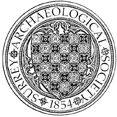Cocks Farm, Abinger
Research excavation by S Dyer for SyAS of part of the Roman villa partially excavated in the 1870s. A total of five rooms were revealed, two of which were excavated to floor level. In one of these rooms the floor was found to be constructed of chalk mixed with crushed tile, the other was found to have a partially damaged mosaic, stylistically dating to the 4th century. Very little evidence was found to date the abandonment of the villa, although a layer of charcoal and ash, mixed with roofing tile, suggests that the building was eventually destroyed by fire. (296)


